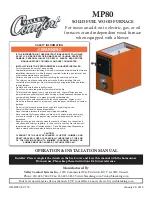
12
• For optimal performance, vent the furnace through a wall
that experiences the least exposure to winter winds.
• Termination kits consist of two face plates and an
insulating gasket to seal the exterior surface.
• The hole in the wall must be sized closely to the
diameter of the pipe.
• The pipe that penetrates the wall should be long
enough that it can be held in place by standard close
fi tting couplings.
• Face plates are secured to both sides of the wall by
the couplings, and the gasket is retained against the
wall by the exterior face plate.
• Face plates must be fastened to the wall. Exterior face
plates must be fl ashed to prevent water infi ltration.
If termination kits are not used, these requirements
must be followed:
• The hole size cut through the exterior wall is smaller
than the outside diameter of the couplings.
• The vent pipe extends through the wall approximately
1" and the gap between the wall and pipe is sealed.
• Couplings are applied to the vent pipe on the interior
and exterior sides of the wall.
NOTE:
This insures the
pipe can not be pushed or pulled through the wall.
• The combustion air inlet pipe must have a 90 degree
termination elbow, and pointed downwards as shown
in Figure 6 & Figure 9 (page 13).
Outdoor Terminations - Vertical Venting
Termination spacing requirements from the roof and from
each other are shown in Figure 9.
• The roof penetration must be properly fl ashed and
waterproofed with a plumbing roof boot or equivalent
fl ashing.
• The combustion air intake must be provided with an
elbow opening downward.
Vent and combustion air piping may be installed in an
existing chimney which is not in use provided that:
• Both the exhaust vent and air intake run the length of
the chimney.
• The top of the chimney is sealed and weatherproofed.
• The termination clearances shown in Figure 9 are
maintained.
• No other gas fi red or fuel-burning equipment is vented
through the chimney.
Vent Freezing Protection
• When the vent pipe is exposed to temperatures below
freezing (i.e., when it passes through unheated spaces,
chimneys, etc.) the pipe must be insulated with 1/2
inch thick sponge rubber insulation, Armafl ex-type
insulation or equivalent. Insulating pipe is important
to avoid condensate icing.
• Table 3 (page 13) lists the maximum length of fl ue pipe
that can travel through an unconditioned space or an
exterior space. The total vent length must not exceed
Outside
Wall
Support
Vent Configuration to
Provide 12" Minimum
height above
Snow Level.
1/2"
Armaflex
Insulation or
Equivalent
(if required)
12" Above
Maximum
Expected
Snow Level
12" Min.
19" Max.
Figure 8. Alternate Horizontal Vent Installation
12" Min.
to Maxim
um
Expected Sno
w Le
vel
Typical Both Pipes
36" max.
8" min.
Exhaust V
ent
Right Side Option
Mounting Kit
Faceplate Secured
to Wall with Screws
Typical Both Pipes
Combustion
Air Inlet
Inlet Exhaust
Both Sides
Exhaust Vent
Left Side Option
90°
Elbo
w
Figure 6. Exhaust and Combustion Air
Pipe Clearances
12 in.
12 in.
4 ft.
Note 3
Less
than
10 ft.
3 ft.
NOTES:
1. All dimensions shown are minimum requirements.
2. Exterior vent terminations must be located at
least 12” above the maximum expected snow level.
3. Mechanical draft vent terminal
4. Direct vent terminal - more than 50,000 Btuh.
5. Direct vent terminal - less than 50,000 Btuh.
9 in.
4ft.
Forced
Air Inlet
Notes
2 & 4
Note 3
Notes
2 & 3
Notes
2 & 5
Figure 7. Vent Locations













































